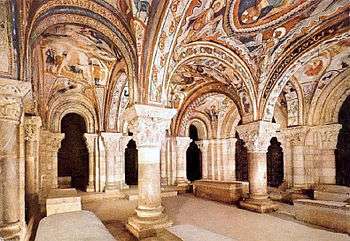Elvira of Castile, Queen of León
| Elvira García of Castile | |
|---|---|
| Born | c. 978 |
| Died | 1017 |
| Spouse | Bermudo II of León |
| Father | García Fernández of Castile |
| Mother | Ava of Ribagorza |
Elvira García (c. 978–1017), was Queen consort of Leon by marriage to King Bermudo II, and co-regent of Leon jointly with Count Menendo González during the minority of her son Alfonso V from 999 until 1008.
Life
Although the year of her birth is not documented, she must have been born shortly before or after 978 since she does not appear with her older sisters, Urraca and Toda, in the foundational charter of the Infantado of Covarrubias in November 24 of that year.[1] Her husband, Bermudo II of León was her first cousin,[2] if Bermudo's debated filiation as the son of Queen Urraca Fernández is correct.[lower-alpha 1]
The marriage was celebrated near the end of November 991[3] and both appear together confirming royal charters as of 992. The marriage, which took place after Bermudo repudiated his first wife, Velasquita Ramírez between 988 and 991, sealed an alliance between the Kingdom of León and the County of Castile which significantly strengthened the Leonese crown.[2]

Bermudo II died in September 999. He was succeeded by his son, Infante Alfonso, a minor, anointed king by October 13 of that year, under the tutorship of his mother, Queen Elvira.[4] The document where Alfonso appears for the first time as King, was confirmed by his mother, followed by count Menendus Gundisaluis comes (Count Menendo González), Santius, dux, Garsea prolis (Sancho, duke, son of García, i.e., Sancho García, Elvira's brother, in addition to several bishops and magnates of the realm.[5] In 1004, Count Sancho García, with the support of his sister Queen Elvira, challenged Count Menendo's tutorship of his nephew, the young King Alfonso. To avoid an armed conflict, both sought the arbitration of the Córdoban hajib al-Muzaffar whose deputy, the qadi of the Mozarabic community of Córdoba, Asbag bin Abd Allah bin Nabil, ruled in favour of Menendo who continued to be the king's tutor until his death in October 1008, after which Alfonso ruled on his own.[6]
The good relations between Alfonso and his maternal uncle, Count Sancho García, were broken in 1014 when a member of the Banu Gómez clan named Munio Fernández, who seemed to count with King Sancho's support, rebelled against the king. "This rupture coincided or rather gave rise to Queen Elvira's retirement in Oviedo where she died in the autumn of 1017".[7] Elvira's presence is recorded for the last time on August 18, 1017 with her son making a donation to the Cathedral of Santiago de Compostela.[8] She was buried at the Pantheon of the Kings at the Basilica of San Isidoro in León.[9]
Descendants
Elvira and Bermudo II had three children:
- Alfonso V of León;
- Sancha Bermúdez, who lived in Galicia;[10]
- Teresa Bermúdez (died on April 25, 1039).[10] According to Bishop Pelagius of Oviedo, after her father's death, her brother Alfonso gave her in marriage to Almanzor.[10]The Arab Muslim historiographer and historian Ibn Khaldun wrote that in 993, King Bermudo sent his daughter Teresa to Almanzor who made her his slave, freed her later and then married her.[10] Hence, according to both of these sources, Teresa was given by her father or her brother to Almanzor and after being freed, she returned to the Kingdom of León where she became a nun at the Monastery of San Pelayo in Oviedo.[11] Modern historians question the veracity of these events and believe that Teresa is confused with one of the daughters of King Sancho II of Pamplona, called Urraca or Abda, who was given by her father to Almanzor in 983 since Teresa was not born until after 991, the year of her parent's wedding.[12]
Family tree
| Family tree of Elvira of León | |||||||||||||||||||||||||||||||||||||||||||||||||||||||||||||||||||||||||||||||||||||||||||||||||||||||||||||||||||||||||||||||||||||||||||||||||||||||||||||||||||||||||||||||||||||||||||||||||||||||||||||||||||||||||||||||||||||||||||||||||||||||||||||||||||||||||||||||||||||||||||||||||||||||||||||||||||||||||||||||||||||||||||||||||||||||||||||||||||||||||||||||||||||||||||||||||||||||||||||||||||||||||||||||||||||||||||||||||||||||||||||||||||||
|---|---|---|---|---|---|---|---|---|---|---|---|---|---|---|---|---|---|---|---|---|---|---|---|---|---|---|---|---|---|---|---|---|---|---|---|---|---|---|---|---|---|---|---|---|---|---|---|---|---|---|---|---|---|---|---|---|---|---|---|---|---|---|---|---|---|---|---|---|---|---|---|---|---|---|---|---|---|---|---|---|---|---|---|---|---|---|---|---|---|---|---|---|---|---|---|---|---|---|---|---|---|---|---|---|---|---|---|---|---|---|---|---|---|---|---|---|---|---|---|---|---|---|---|---|---|---|---|---|---|---|---|---|---|---|---|---|---|---|---|---|---|---|---|---|---|---|---|---|---|---|---|---|---|---|---|---|---|---|---|---|---|---|---|---|---|---|---|---|---|---|---|---|---|---|---|---|---|---|---|---|---|---|---|---|---|---|---|---|---|---|---|---|---|---|---|---|---|---|---|---|---|---|---|---|---|---|---|---|---|---|---|---|---|---|---|---|---|---|---|---|---|---|---|---|---|---|---|---|---|---|---|---|---|---|---|---|---|---|---|---|---|---|---|---|---|---|---|---|---|---|---|---|---|---|---|---|---|---|---|---|---|---|---|---|---|---|---|---|---|---|---|---|---|---|---|---|---|---|---|---|---|---|---|---|---|---|---|---|---|---|---|---|---|---|---|---|---|---|---|---|---|---|---|---|---|---|---|---|---|---|---|---|---|---|---|---|---|---|---|---|---|---|---|---|---|---|---|---|---|---|---|---|---|---|---|---|---|---|---|---|---|---|---|---|---|---|---|---|---|---|---|---|---|---|---|---|---|---|---|---|---|---|---|---|---|---|---|---|---|---|---|---|---|---|---|---|---|---|---|---|---|---|---|---|---|---|---|---|---|---|---|---|---|---|---|---|---|---|---|---|---|---|---|---|---|---|---|---|---|---|---|---|---|---|---|---|---|---|---|---|---|---|---|---|---|---|---|---|---|---|---|---|---|---|---|---|---|---|---|---|---|---|---|---|---|---|---|---|---|---|---|---|---|
| |||||||||||||||||||||||||||||||||||||||||||||||||||||||||||||||||||||||||||||||||||||||||||||||||||||||||||||||||||||||||||||||||||||||||||||||||||||||||||||||||||||||||||||||||||||||||||||||||||||||||||||||||||||||||||||||||||||||||||||||||||||||||||||||||||||||||||||||||||||||||||||||||||||||||||||||||||||||||||||||||||||||||||||||||||||||||||||||||||||||||||||||||||||||||||||||||||||||||||||||||||||||||||||||||||||||||||||||||||||||||||||||||||||
Notes
- ↑ If Bermudo was the son of Urraca Fernández, both were grandchildren of Count Fernán González.
References
- ↑ Martínez Diez 2005, p. 553.
- 1 2 Martínez Diez 2005, p. 554.
- ↑ Martínez Diez 2005, pp. 524,554.
- ↑ Martínez Diez 2005, p. 562.
- ↑ Martínez Diez 2005, pp. 563, 592.
- ↑ Martínez Diez 2005, pp. 592–593, 650.
- ↑ Martínez Diez 2007, pp. 74–75.
- ↑ Martínez Diez 2005, p. 652.
- ↑ Arco y Garay 1954, pp. 158–160.
- 1 2 3 4 Fernández del Pozo 1999, p. 30.
- ↑ Torres Sevilla 1999, p. 64.
- ↑ Fernández del Pozo 1999, p. 33.
Bibliography
- Arco y Garay, Ricardo del (1954). Sepulcros de la Casa Real de Castilla (in Spanish). Madrid: Instituto Jerónimo Zurita. Consejo Superior de Investigaciones Científicas. OCLC 11366237.
- Fernández del Pozo, José María (1999). Reyes de León: Alfonso V (999-1028) -Vermudo III (1028-1037) (in Spanish). Burgos: La Olmeda, S.L. ISBN 84-89915-07-5.
- Martínez Díez, Gonzalo (2005). El Condado de Castilla (711–1038): la historia frente a la leyenda (in Spanish). Valladolid. ISBN 84-9718-275-8.
- Martínez Díez, Gonzalo (2007). Sancho III el Mayor Rey de Pamplona, Rex Ibericus (in Spanish). Madrid: Marcial Pons Historia. ISBN 978-84-96467-47-7.
- Salazar y Acha, Jaime de (2013). "Reflexiones e hipótesis sobre algunas incógnitas genealógicas de la antigua dinastía asturleonesa". Boletín de la Real Academia de la Historia (in Spanish). Madrid: Real Academia de la Historia. pp. 275–296. ISBN 978-84-8951241-2.
- Sánchez Candeira, Alfonso (1950). "La reina Velasquita de León y su descendencia". Hispania. Revista española de Historia (in Spanish) (40). Madrid: C.S.I.C. pp. 449–505. ISSN 0018-2141.
- Torres Sevilla-Quiñones de León, Margarita Cecilia (1999). Linajes nobiliarios de León y Castilla: Siglos IX-XIII (in Spanish). Salamanca: Junta de Castilla y León, Consejería de educación y cultura. ISBN 84-7846-781-5.